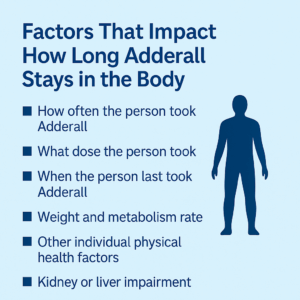How Long Does Adderall Stay in Your System?
Adderall, a prescription medication used to treat attention deficit hyperactivity disorder (ADHD) and narcolepsy, may be misused. Misuse can lead to addiction, overdose, and significant adverse effects such as cardiovascular disease, unhealthy weight loss, and psychotic symptoms. People who have become addicted to the drug may benefit from professional substance use treatment.
What Is Adderall?
Adderall is a stimulant medication used to treat attention-deficit hyperactivity disorder (ADHD) and narcolepsy. It contains a mixture of both amphetamine and dextroamphetamine. Branded pharmaceutical formulations that include this stimulant combo include Adderall (immediate release), Adderall XR (extended release), and Mydayis (extended release). Immediate-release forms of the drug are available in oral tablet form; extended-release forms of the drug are available as capsules to be taken by mouth.1,2
The effects of Adderall last for varying amounts of time depending on the version of the drug. The immediate-release Adderall version lasts around 4–6 hours per dose, while Adderall XR, the extended-release version, only needs to be taken once each morning.2
Adderall is one of the most widely prescribed ADHD treatment medications. In 2022, nearly 3.8 million people aged 12 and older misused prescription amphetamine products (which includes Adderall as well as Dexedrine, Vyvanse, and similar drugs).3
Is Adderall Misused?
While many people take Adderall with a doctor’s prescription following a diagnosis of ADHD or narcolepsy, it may also be misused.
People who misuse Adderall may take someone else’s medication or buy counterfeit pills illegally. They may also take it in a way other than prescribed (by crushing, snorting, or injecting it) in an attempt to intensify the high. High school and college students may use the drug to improve their performance in school, and adults may take it to improve their memory or perform better at work.4
However, misusing the drug is dangerous and can lead to addiction, anger, paranoia, psychosis, and heart problems.4
How Long Does Adderall Last In the Body?
Adderall is absorbed in the gastrointestinal tract and either deactivated by the liver or eliminated unchanged in the urine. About 20-25% of it is converted to metabolites, including hippuric and benzoic acids.5
How long Adderall stays in a person’s system depends on a number of factors. For example, the rate at which the drug is eliminated from a person’s body can be affected by the pH of the person’s urine. A person with a low urine pH tends to eliminate the drug faster, while a person with a higher pH may eliminate the drug more slowly.5
 Other factors that can affect how long Adderall stays in a person’s system include:6
Other factors that can affect how long Adderall stays in a person’s system include:6
- How often the person took Adderall.
- What dose the person took.
- When the person last took Adderall.
- Weight.
- Kidney or liver impairment.
Adderall and Drug Testing
Employers, law enforcement, medical and mental health professionals, and sports organizations commonly test for amphetamines, which is found in Adderall. Urine tests, blood tests, hair tests, and saliva tests are all used to determine whether a person has used Adderall or similar drugs.
Is Adderall Addictive?
As previously mentioned, Adderall misuse can lead to addiction. An addiction can interfere with many areas of a person’s life, such as their health, relationships, schoolwork, and employment.4
Signs of a stimulant use disorder, the clinical term for addiction include:7
- Taking Adderall in larger amounts or over a longer period of time than intended.
- Lacking the ability to cut back on Adderall use despite efforts or a desire to do so.
- Spending a large amount of time acquiring Adderall, using it, or recovering from its effects.
- Craving Adderall.
- Difficulty taking care of responsibilities at work, school, or home due to Adderall use.
- Continuing to use Adderall despite it causing or worsening social or interpersonal problems.
- Failing to participate in previously enjoyed activities in favor of Adderall use.
- Using Adderall in dangerous situations.
- Continuing to use Adderall despite it causing or worsening physical or psychological problems.
- Building tolerance to Adderall, meaning you have to take progressively higher doses of the drug to get the same desired effect. (This criterion doesn’t count toward diagnosis if Adderall is being used as prescribed).
- Experiencing withdrawal symptoms when use is suddenly reduced or stopped. (This criterion doesn’t count toward diagnosis if Adderall is being used as prescribed).
Misuse and addiction also increase the risk of overdose. For example, individuals who develop tolerance to the drug may steadily increase their intake of Adderall, raising the likelihood of taking too much and overdosing.
Symptoms of a stimulant overdose include:1
Emergency medical services may be required in the event of an overdose, which can result in death.1
What Happens When You Stop Using Adderall?
Withdrawal symptoms may occur in people who have chronically misused the drug and developed significant physiological dependence.
Stimulant withdrawal symptoms may include:8
- Drug cravings.
- Fatigue.
- Anxiety.
- Depression.
- Agitation.
- Poor concentration.
- Insomnia or sleeping more than normal.
- Increased appetite.
- Paranoia.
- Decrease in mental and physical activities.
Withdrawal symptoms typically disappear after several days of abstinence but can persist for 3 to 4 weeks in some instances.8
Getting Help for Adderall Addiction
Adderall can be life-changing for individuals struggling with ADHD and narcolepsy. However, if your misuse has turned into an addiction, substance use treatment programs can help you or someone you love break free from Adderall addiction. Behavioral therapies, such as cognitive-behavioral therapy (CBT) and contingency management, can help you stop your Adderall use and learn strategies to prevent relapse. Cognitive-behavioral therapy teaches you how to manage your triggers and adjust thought patterns that lead to Adderall misuse, while contingency management rewards you for behaviors related to sobriety.4
Treatment may typically start with medically monitored detox to allow your body to rid itself of Adderall. Following detox, a more comprehensive treatment program—either in an inpatient or outpatient setting—can help you identify the thoughts, emotions, and behaviors that led to substance misuse and provide you with coping skills for sustained recovery.
If you or a loved one struggle with Adderall or other substance addiction, reach out to American Addiction Centers’ knowledgeable and compassionate admissions navigators, who can listen to your story, explain your options, verify your insurance, and help you start your path to recovery.
